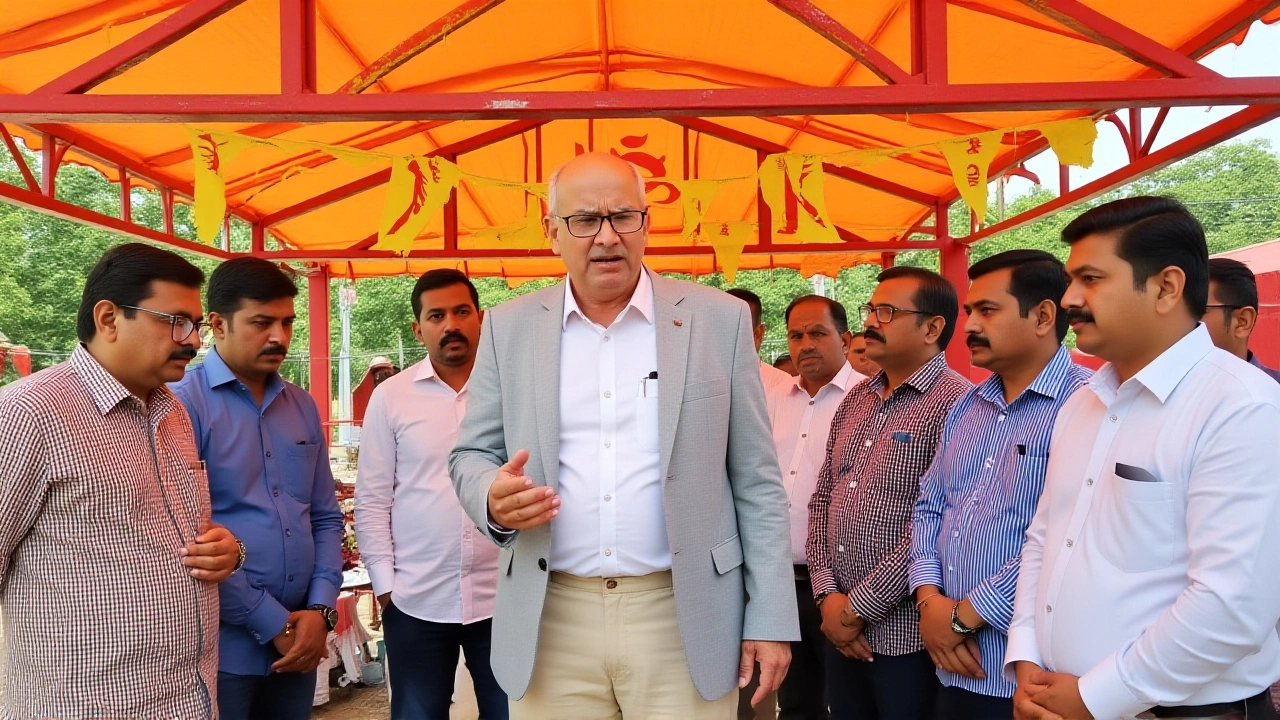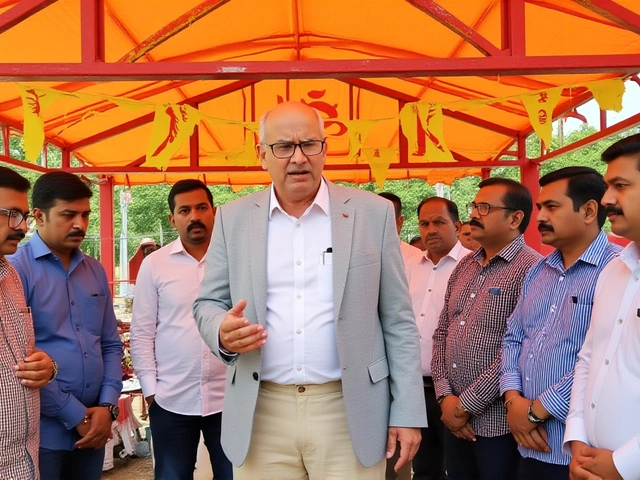- Home
- Religion And Spirituality
- Kanpur DM Orders Integrated Command Centers for Safer Chhath Puja 2025

Kanpur DM Orders Integrated Command Centers for Safer Chhath Puja 2025
When Kanpur District Magistrate walked the ghats along the Ganges this week, the air was heavy with incense and the murmur of thousands of devotees preparing for Chhath Puja. The official inspection, held just weeks before the festival’s slated start in early November 2025, wasn’t just a ceremonial stroll – it was a full‑blown safety audit. The magistrate issued stark instructions: every major worship site must host an Integrated Command Center, pulling together police, electricity, municipal, irrigation and health agencies under one roof.
Why Chhath Puja Needs Extra Guardrails in Kanpur
Chhath Puja, a four‑day sun‑worship rite rooted in Bihar, has migrated eastward in recent decades, drawing large crowds to Kanpur’s riverfront. In 2022, a sudden surge of worshippers caused a crush at the Bithoor ghat, prompting a handful of injuries and a bruised reputation for the district’s crowd‑control plan. Since then, officials have been tinkering with protocols, but the 2025 edition promised something bigger: more devotees, longer evenings, and a heightened risk of heat‑related ailments.
That history is what nudged the magistrate to tighten the bolts. “We cannot afford another incident where a miscommunication turns into a tragedy,” the official reportedly told on‑site staff. The warning wasn’t empty – it was backed by a concrete framework that mirrors the command centers used during the Kumbh Mela.
The On‑Ground Inspection: What Was Seen
The walkthrough began at the bustling Kanpur Municipal Corporation‑managed ghat near the Ganga’s main bend. The magistrate’s team noted lingering litter, spotty lighting, and a patchwork of temporary medical tents. “Electricity must never flicker when the sun sets,” he reminded engineers from Kanpur Electricity Supply Company (KESCO), prompting a promise to install backup generators at every site.
Next stop was the newly‑proposed crowd‑control zone at the Bithoor Sanjay Dutt Ghat. Representatives of the Uttar Pradesh Police outlined a plan to deploy 200 officers, equipped with handheld radios linked to a central hub. The magistrate stressed that officers should not only patrol but also manage vehicle parking to prevent bottlenecks on the adjoining lanes.
Health officials from the Uttar Pradesh Health Department unveiled a roster of 15 mobile medical units, each staffed with a doctor, two nurses, and a paramedic. “We’ll station a unit every 500 meters along the ghats,” one commander said, adding that ambulances will be on standby at the municipal parking lot.
Integrated Command Centers: The New ‘Control Room’ Model
So, what does an Integrated Command Center actually look like? Think of it as a pop‑up operations bunker set up inside the municipal office near each ghat. The table will hold laptops displaying live feeds from CCTV, water‑level sensors supplied by the Uttar Pradesh Irrigation Department, and a dashboard tracking electricity consumption from KESCO.
- Security Hub: Police officers coordinate crowd‑flow diagrams and dispatch units on the ground.
- Power Desk: KESCO technicians monitor voltage, ready to switch to generators within seconds.
- Sanitation Station: Municipal workers log waste‑collection schedules and deploy cleaning crews after each evening aarti.
- Health Corner: Doctors log incoming cases and request additional medical support if needed.
- Water Watch: Irrigation engineers watch river gauges to warn of sudden surges.
The command centers will operate 24/7 throughout the festival, feeding information to a district‑wide emergency operations centre based at the Collectorate. In theory, a single alert—say, a power dip—triggers an instant cascade of responses, preventing the kind of domino effect that plagued previous years.
Reactions: Officials, Volunteers, and Devotees Speak
Local councillor Anil Kumar, who heads the municipal sanitation wing, welcomed the move. “We’ve been scrambling for cleaning crews after each evening. A dedicated desk means we can plan ahead, not react in panic,” he explained.
On the other side, a senior priest at the Bithoor ghat expressed cautious optimism. “Our rituals must stay pure, but safety can’t be an afterthought. If the command center respects the sanctity of the space, I’m all for it,” he said, eyeing the proposed satellite screens.
Devotees themselves seemed relieved. “Last year, the lights went out during the sunset prayer,” said 58‑year‑old Sushma Devi, who travels from Lucknow each year. “If there’s a backup, I won’t have to worry about missing the offering.”
Potential Challenges and How They Might Play Out
Despite the enthusiasm, the plan isn’t without hurdles. First, staffing the command centers requires a delicate balance: too many officials could create bureaucratic traffic, while too few might leave gaps. Training sessions slated for late September will attempt to iron out procedural kinks.
Second, the river’s unpredictable monsoon‑linked swell could outpace the irrigation department’s sensor network. Some experts suggest installing additional floating buoys to supplement the static gauges.
Lastly, funding remains a gray area. While the magistrate’s order didn’t disclose a budget, the district’s fiscal note for FY‑2025‑26 earmarks ₹2.3 crore for festival safety—roughly $310,000. Whether that sum covers generators, extra police uniforms, and medical kits is still up for debate.
What Comes Next: Timeline to the Festival
The magistrate’s office has set a hard deadline: all command centers must be fully operational by October 20, 2025, giving a two‑week window before the first sunrise aarti on October 28. Follow‑up inspections are scheduled for October 5 and October 15, with the Collectorate publishing compliance reports on its website.
In parallel, the Uttar Pradesh Department of Culture is rolling out a public awareness campaign, urging devotees to use designated entry points and adhere to the dress code for safety. Mobile alerts will remind attendees of nearest medical camps and sanitation stations.
If everything runs smoothly, Kanpur could set a new benchmark for festival safety in the region, perhaps inspiring similar frameworks for Holi, Diwali, and even secular events like the annual trade expos.
Key Takeaways
- The District Magistrate mandated Integrated Command Centers at every major Chhath Puja ghat.
- Police, KESCO, municipal, irrigation, and health departments will co‑locate under one roof.
- Safety measures target past crowd‑control failures and power outages.
- Command centers must be live by October 20, 2025, ahead of the festival’s start.
- Stakeholders from officials to devotees are largely supportive, pending effective implementation.
Frequently Asked Questions
How will the Integrated Command Centers improve safety for devotees?
By colocating police, power, sanitation, irrigation and health officials, the centers enable real‑time coordination. If a crowd surge is detected, police can redirect foot traffic instantly, while medical teams stand ready to treat any injuries, and KESCO can prevent blackouts that would otherwise cause panic.
What specific responsibilities does KESCO have during the festival?
KESCO must ensure uninterrupted electricity at every ghat, install backup generators, and monitor voltage fluctuations. Their technicians will also coordinate with the command center to quickly address any power failures that could affect lighting and sound systems used during the aartis.
Which department will handle waste management and sanitation?
The Kanpur Municipal Corporation is in charge of cleaning the ghats before, during, and after the rituals. They will deploy portable toilets, schedule nightly cleaning crews, and coordinate waste collection with the command center’s sanitation desk.
What past incidents prompted these new measures?
In 2022, a sudden influx of worshippers at the Bithoor ghat led to a crush that injured dozens, and a power outage during the evening aarti caused darkness and confusion. Those events highlighted gaps in crowd‑control, lighting, and medical response, driving the magistrate to adopt a more integrated approach for 2025.
When does the 2025 Chhath Puja actually begin?
The festival’s first sunrise aarti is scheduled for October 28, 2025, followed by three more days of rituals ending on November 1. All command centers must be fully functional at least a week before the opening ceremony.

Caspian Harrington
Hi there! My name is Caspian Harrington and I'm a blogger who specializes in entertainment, fashion, and beauty. I have a passion for writing about films, especially those that intertwine style and artistry in unique ways. With a keen eye for detail, I enjoy analyzing movie costume design and exploring the influence of fashion on the big screen. Join me as I dive into the cinematic world and share my thoughts on everything from classic films to the latest blockbusters.
About
Welcome to Filmy Haven India, your ultimate destination for the latest in Indian cinema, reviews, and entertainment news. Immerse yourself in the world of Bollywood, Tollywood, and more, as we bring you exclusive content, interviews, and updates on your favorite stars and movies. Join our vibrant community of passionate film buffs and celebrate the magic of Indian cinema with Filmy Haven India.

